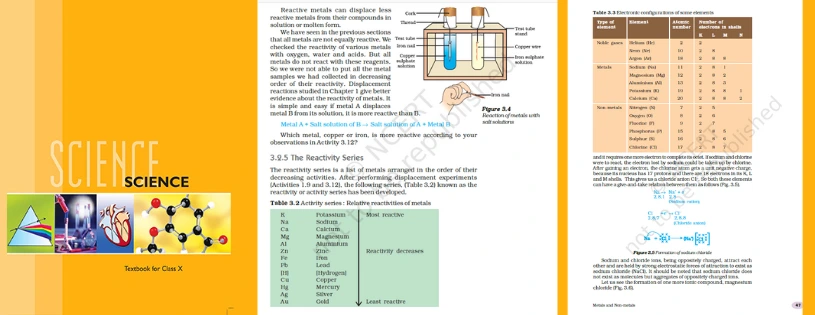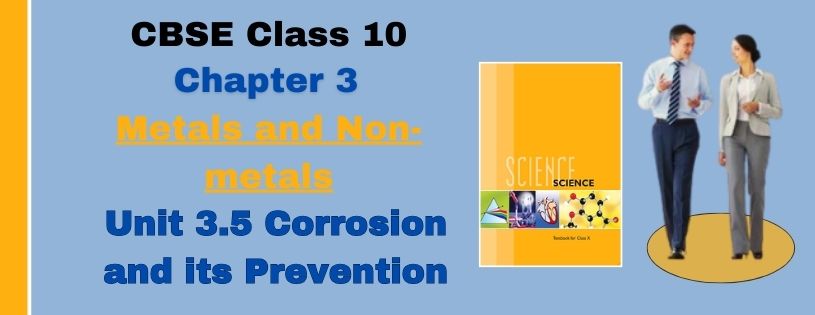CBSE Class 10th Corrosion and its Prevention & Preparations Downloads
Two main classes of elements are distinguished from one another by their physical and chemical characteristics. Metals and nonmetals are these two categories of elements. When oxygen and moisture are present in the atmosphere, chemically active metals corrode. Higher reactivity metals (including zinc, iron, magnesium, and tin) are far more prone to corrosion.
A refined substance can naturally undergo corrosion to change into a more chemically stable state, such as its oxide, hydroxide, or sulfide. It is the instantaneous breakdown of a substance (usually a metal) as a result of environmental chemical and/or electrochemical processes. The beneficial qualities of metal and buildings, such as their strength, appearance, and permeability to liquids and gasses, are eroded by corrosion. The breakdown of metals due to a chemical reaction occurring in the nearby environment is known as corrosion. This article aims to explore several aspects of corrosion, including its definition, kinds, causes, prevention, and effects.
Corrosion Definition
According to the definition of corrosion, it is a natural process that turns pure metals into unwanted chemicals when they mix with other substances like air or water. As the metal interacts with the environment and progressively spreads to the majority of the metal, this reaction damages or disintegrates the metal.
Causes of Corrosion
When a metal interacts with air, hydrogen, an electric current, or even bacteria or dirt, it starts to corrode. Additionally, corrosion may occur when steel or other metals are subjected to extreme stress, which causes materials to fracture.
Example of Corrosion
1. Carbon dioxide is created when iron ore and oxygen in wet air come into contact, covering the ore in a brown layer. This is referred to as iron rusting.
2. A black coating is deposited on silver ore due to the creation of sulfur dioxide when it comes into contact with oxygen in the air. This is referred to as silver tarnishing or corrosion.
3. Copper carbonate is formed when airborne carbon dioxide and copper metals come into contact, covering the copper metal with a green layer. This is referred to as copper tarnishing or corrosion.
The Deal-Grove model is a tool used to explain the rate at which metal rusts or corrodes. This model aids in the prediction and management of the oxide layer's production under various conditions. The weight loss method is another approach to detect corrosion. In this process, a piece of clean, weighed metal is exposed to a rusting environment for a period, cleaned to eliminate rust, and then the weight loss is determined by weighing the piece of metal again.
The formula used to determine the rate of corrosion, or how quickly something rusts, is:
R=kWρAt
Where:
R is the corrosion rate.
Since k is a constant,
W is the metal's weight decrease over time.
A is the exposed metal's surface area, and
ρ represents the metal's density (measured in grams per cubic centimeter).
Corrosion and Its Types
The types of corrosion are listed below:
1.Uniform Corrosion: A uniform coating of rust forms on the metal's surface and spreads throughout its whole surface during uniform corrosion. This kind of corrosion is frequently observed on metals without a surface covering. Lead, zinc, and aluminum are a few metals that are frequently impacted by uniform corrosion.
2.Erosive Corrosion: The mechanical abrasion that results from the relative mobility of corrosive liquids on the metal surface causes erosive corrosion. This causes cavities to grow as well as progressive surface deterioration of metals due to the abrasion of quickly flowing fluids. This kind of corrosion is frequently observed in metals that contain flowing fluids.
3.Fretting Corrosion: When two materials are linked together, fretting corrosion takes place at their point of contact. This often shows up when there are slips and variances in the contact area. Generally speaking, clamped surfaces, bolted and riveted connections, etc., exhibit this kind of corrosion.
4.Corrosion Fatigue:The failure of a material as a result of repetitive stress application is known as fatigue material. Corrosion fatigue is the term used to describe metal fatigue that develops in a corrosive environment. By stopping the material's fatigue resistance, this may be made better.
5.Intergranular Corrosion: Corrosion that develops on the granular layer without affecting the grains is known as intergranular corrosion. It manifests when there is a discernible variation in the reactivity of grains and grain borders to contaminants. The reason for the variation in reactivity might be attributed to substandard welding, heat treatment, copper, stainless steel, etc.

Prevention of Corrosion
The corrosion protection tips below illustrate the various approaches that may be used to stop corrosion.
1.Electroplating: Electric current is used in the electroplating process to apply a thin coating of metal on top of a less costly metal. Usually, it's done to provide the less expensive metals a finishing touch and add characteristics like anti-corrosion and anti-rust.
Two separate metals, an electrolyte solution, two electrodes, a battery or other source that can produce electricity, and two electrodes are needed to electroplate a metal.
One metal becomes positively charged and the other negatively charged as soon as the electricity is turned on. The positively charged metal's molecules eventually move to the negatively charged metal's surface, forming an extremely thin coating.
Copper and brass electroplating is a popular use. Copper and brass would be submerged in an electrolyte solution in such a scenario.
Every metal component and battery would have an electrolyte linked to it. The copper metal will gradually adhere to the brass when the electricity is switched on, covering the brass's surface with a thin layer of copper. You would most likely need a solution containing copper sulfide in such a situation.
2.Galvanization: A thin layer of zinc is applied to the iron during this procedure. Typically, iron is dipped into molten zinc to accomplish this. The iron's inside is shielded from corrosion by this layer of zinc.
3.Painting and Greasing: The application of a coating, such as paint or grease, can shield the metal from the elements and stop corrosion.
4.Selection of Optimum Material: Selecting the best material might also aid in preventing corrosion. Stainless steel and aluminum have excellent resistance against corrosion.
Using Corrosion Inhibitors: The substance known as a corrosion inhibitor is able to slow down the pace of corrosion.
Corrosion Examples, Reactions and Effects
Metals undergo corrosion as a result of reactions with the surrounding chemicals or air. Let's examine a copper example.
1. Copper Corrosion: Red copper (I) oxide is produced when copper and oxygen interact in the presence of air:
Cu2O(s) = 2Cu(s) + ½O2(g)
Cu2O then becomes into dark CuO.
2CuO(s) = Cu2O(s) + ½O2(g)
In the air, CuO combines with CO2, SO3, and H2O to generate green Cu4SO4(OH)6 (brochantite) and blue Cu2(OH)2 (malachite). Copper turns bluish-green for this reason.
For instance, this process causes the copper-coated Statue of Liberty to become blue-green.
2. Silver Tarnishing: Silver sulfide (Ag2S) is formed when silver comes into contact with sulfur and sulfur compounds in the air, causing it to become black. This reaction takes place when silver combines with atmospheric hydrogen sulfide (H2S), which is created by specific industrial operations.
Ag2S(s) + H2(g) = 2Ag(s) + H2S(g).
3. Corrosion of Iron (Rusting): Iron rusting is a frequent phenomenon that occurs when iron is exposed to air or water. One way to conceptualize this process is as a standard electrochemical cell reaction. Iron loses electrons and changes into Fe2+, which is regarded as the anode. After that, the electrons go to the opposite side and mix with the H+ ions there. Water (H2O) or carbonic acid (H2CO3) in the environment (referred to as the cathode) both release these H+ ions.
H2O⇌H++OH−
H2CO3⇌2H++CO23
Anode reaction
2Fe(s)→2Fe2++4e−
E0Fe2+/Fe=−0.44 V
Cathode reaction
O2(g) + 4H + (aq) + 4e−⟶2H2O(l)EoH+/O2/H2/O=1.23 V
Overall reaction
E∞cell = 1.67 V for 2Fe(s)+O2(g)+4H+(aq)→2Fe2+(aq)+2H2O(l).
The oxygen in the environment reacts with the Fe2+ ions created at the anode to produce Fe3+ and Fe2O3, which when hydrated takes the form of rust.xH
Fe2O3∅xH2O
Fe2++3O2→2Fe2O3.
Rust: Fe2O3 + x H2O -> Fe2O3.x H2O
Factor Affecting Corrosion: We will talk about the following aspects that cause corrosion:
1.contamination with substances like salt (e.g., NaCl).
2.The rate of corrosion rises with temperature.
3.metal exposure to gasses used in air conditioning, including CO2, SO2, So3, etc.
4.metal exposure to moisture, particularly salt water (which accelerates corrosion).
5.The rate of corrosion rises with temperature.
6.Certain oxides, like AL203, can further inhibit corrosion by forming an insoluble protective coating. Others, like rust, break down quickly and reveal the residual metal.
Extra Points to Remember
1.The Deal-Grove model is frequently used to predict when the oxide layer will form. It aids in the prediction of the oxide layer's development. Meanwhile, corrosion is measured using the weight loss method.
2.In the weight loss technique, a clean, weighed piece of metal or alloy is exposed to a corrosive environment for a predetermined amount of time. After the corrosion is eliminated by cleaning, the piece is weighed to ascertain the weight loss of the metal or alloy.
3.Different materials are affected by corrosion in different ways. Listed below are a few of them:
Corrosion has several effects on different materials. Below are listed some of them:
4.Natural resources are wasted due to this process
5.It can also cause hazardous situations such as weakening the structure of things.
6.Accidents can be caused by corroded materials.
7.It can cause pipelines to break apart or crash. Therefore it is essential to prevent corrosion.
8.Examples of corrosion may include– Copper corrosion, Corrosion of iron, as well as, silver tarnishing.
Conclusion
Metals naturally corrode when exposed to air and moisture, among other environmental variables. To sum up, knowing corrosion is essential for many different sectors. It has an impact on how long machines, buildings, and even common objects last. Inhibitors and coatings are examples of preventive measures that are essential for delaying this process. Prospective engineers must to understand the importance of corrosion control in material science, particularly those getting ready for JEE Main. It's a problem that calls for creative solutions to guarantee the durability and dependability of metal-based items in our everyday lives; it's not merely a chemical reaction.
CBSE Class 10 NCERT Science Topics for a Strong Foundation
| Chapter Name | Metals and Non-metals |
| Topic Number | Topic |
| 3.1 | Properties of Metals and Non-metals |
| 3.2 | Reactivity Series |
| 3.3 | Formation and Properties of Ionic Compounds |
| 3.4 | Basic Metallurgical Processes |
| 3.5 | Corrosion and its Prevention |
List of CBSE Class 10 Science Chapter
| Chapter Number | Chapter Name |
| Chapter 1 | Chemical Reactions and Equations |
| Chapter 2 | Acids, Bases and Salts |
| Chapter 3 | Metals and Non-metals |
| Chapter 4 | Carbon and its Compounds |
| Chapter 5 | Life Processes |
| Chapter 6 | Control and Coordination |
| Chapter 7 | How do Organisms Reproduce? |
| Chapter 8 | Heredity |
| Chapter 9 | Light – Reflection and Refraction |
| Chapter 10 | The Human Eye and the Colourful World |
| Chapter 11 | Electricity |
| Chapter 12 | Magnetic Effects of Electric Current |
| Chapter 13 | Our Environment |
List of CBSE Class 10 Mathmetics Chapter
| Chapter Number | Chapter Name |
| Chapter 1 | Real Numbers |
| Chapter 2 | Polynomials |
| Chapter 3 | Pair of Linear Equations in Two Variables |
| Chapter 4 | Quadratic Equations |
| Chapter 5 | Arithmetic Progressions |
| Chapter 6 | Triangles |
| Chapter 7 | Coordinate Geometry |
| Chapter 8 | Introduction to Trigonometry |
| Chapter 9 | Some Applications of Trigonometry |
| Chapter 10 | Circles |
| Chapter 11 | Areas Related to Circles |
| Chapter 12 | Surface Areas and Volumes |
| Chapter 13 | Statistics |
| Chapter14 | Probability |
FAQs
Que1. Are all Metals corroded easily?
Ans. No, not all metals corrode easily.
2. What are the advantages and disadvantages of Corrosion?
Ans.
Advantages:
Rust can provide a protective layer for metals, preventing further corrosion.
Controlled corrosion processes like patination can enhance aesthetics, such as the green color on copper statues.
Corrosion can act as a sacrificial protection mechanism, where one metal corrodes to protect another.
Disadvantages:
Corrosion weakens metal structures, leading to structural failure.
It reduces the lifespan of materials and components, increasing maintenance and replacement costs.
Corrosion can cause contamination of products or substances stored in corroded containers, leading to health and safety risks.
Que3 . What is meant by high-temperature corrosion?
Ans. The destruction of materials caused by chemical processes that take place at high temperatures, usually above 400°C (750°F), is referred to as high-temperature corrosion. The characteristics and functionality of the material deteriorate as a result of these reactions, which frequently entail oxidation, sulfidation, or other corrosive processes that are enhanced by heat.
Que4. What is the effect of temperature on corrosion?
Ans. The pace at which corrosion occurs can be greatly accelerated by temperature. Elevated temperatures typically accelerate chemical reactions, resulting in expedited corrosion processes. On the other hand, corrosion processes can be slowed down by lower temperatures.
Que5. What is corrosion?
Ans. The slow degradation of materials—mostly metals—caused by chemical interactions with their surroundings is known as corrosion. Over time, this process weakens the material's structure by causing rust or other oxides to develop on its surface.


.webp)

